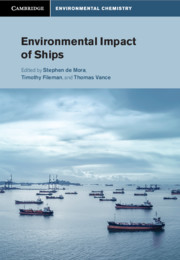Book contents
- Environmental Impact of Ships
- Cambridge Environmental Chemistry Series
- Environmental Impact of Ships
- Copyright page
- Contents
- Contributors
- Preface
- 1 Shipping, Ships and the Environment
- 2 Atmospheric Emissions from Ships
- 3 Oil Pollution from Operations and Shipwrecks
- 4 Waste and Sewage
- 5 Ballast Water
- 6 Biocides from Marine Coatings
- 7 Invasive Species
- 8 Physical Effects of Ships on the Environment
- 9 Ship Noise
- 10 Vessel Strikes and North Atlantic Right Whales
- 11 Nuclear-Powered Vessels
- 12 Environmental Impacts of Shipbreaking
- 13 International Legislative Framework
- 14 Shipping Industry’s Perspective
- 15 Environmental Impacts of Shipping
- Index
- References
9 - Ship Noise
Published online by Cambridge University Press: 22 January 2021
- Environmental Impact of Ships
- Cambridge Environmental Chemistry Series
- Environmental Impact of Ships
- Copyright page
- Contents
- Contributors
- Preface
- 1 Shipping, Ships and the Environment
- 2 Atmospheric Emissions from Ships
- 3 Oil Pollution from Operations and Shipwrecks
- 4 Waste and Sewage
- 5 Ballast Water
- 6 Biocides from Marine Coatings
- 7 Invasive Species
- 8 Physical Effects of Ships on the Environment
- 9 Ship Noise
- 10 Vessel Strikes and North Atlantic Right Whales
- 11 Nuclear-Powered Vessels
- 12 Environmental Impacts of Shipbreaking
- 13 International Legislative Framework
- 14 Shipping Industry’s Perspective
- 15 Environmental Impacts of Shipping
- Index
- References
Summary
Anthropogenic underwater noise has severely increased over the last century and a significant component of noise in marine environments is due to ship traffic. Every year at sea, we observe the continuous movement of more than 60,000 medium to very large commercial vessels, such as cargo ships, bulk carriers, container vessels, tankers, cruise ships and ferries (Equasis, 2015). The incredible increase in commercial maritime trade and the related increase in vessel speed of the last 40 years have raised the amount of noise that ship traffic is spreading throughout the oceans. From the 1960s, when the first measures of noise levels were reported (Wenz, 1962), until the 1990s, underwater noise has almost doubled every 10 years (Andrew et al., 2002; McDonald et al., 2006a; Merchant et al., 2012). While some recent studies describe slowly decreasing low-frequency ocean noise levels at different oceanic locations during the early 2000s (Andrew et al., 2011; Miksis-Olds et al., 2016), the typical and long-term trends for ship noise are still unknown in many regions of the world (Viola et al., 2017).
- Type
- Chapter
- Information
- Environmental Impact of Ships , pp. 225 - 249Publisher: Cambridge University PressPrint publication year: 2020

